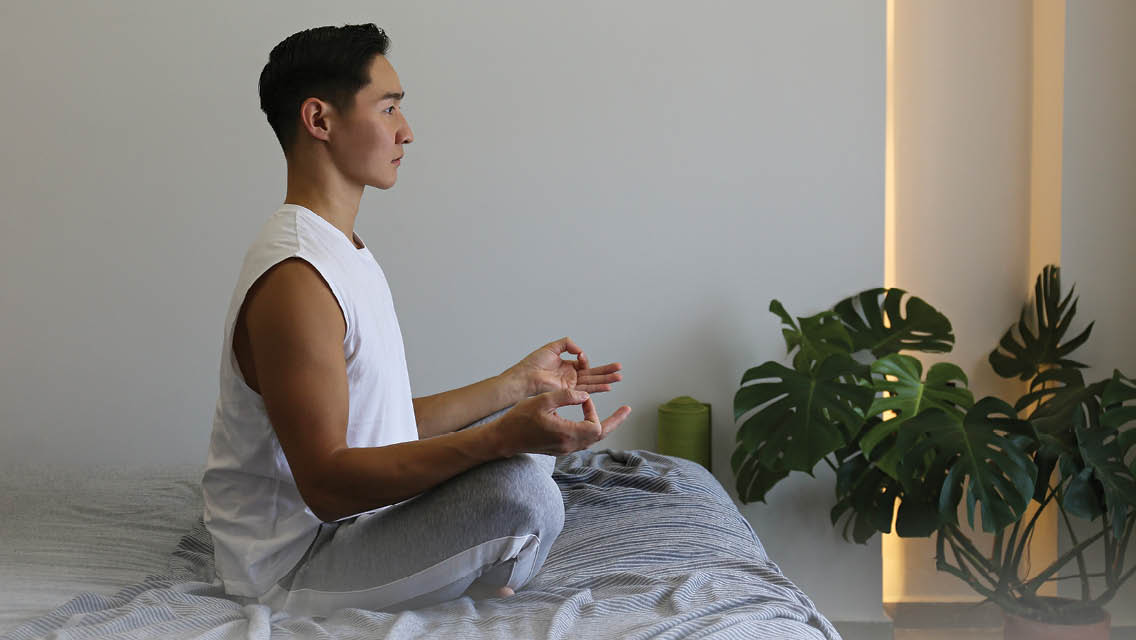Got stress? No doubt you do. Traffic jams, rapid technological change, overscheduling, relationship struggles and other stressors invade our lives on a daily basis, making it easy to feel overwhelmed and out of control. Running at top speed with our minds always three steps ahead, we miss out on much of the joy of being fully present and alive. But it is possible to get off this merry-go-round of distraction and reaction, and to regain a sense of center, purpose and meaning.
It all starts with the breath, says Thomas Crum, an Aikido master, coach, speaker and consultant whose clients include Disney and the United States Air Force Academy. In his new book, Three Deep Breaths: Finding Power and Purpose in a Stressed-Out World, Crum asserts that one of the best ways to hone your stress-response skills is surprisingly simple: Just breathe. Or, more specifically, take Three Deep Breaths.
Stress Arrest
Crum, also the author of Journey to Center and The Magic of Conflict chose to write Three Deep Breaths in an accessible parable format, in part to help readers connect with the emotional components of the stress cycle, and in part to help them side-step the serious “self-improvement” mindset that just creates more things to do.
“Reading about stress management or any other health issue can be stressful in itself,” says Crum. “I believe that taking the stress out of reading, and keeping people involved, is the best way to teach and to learn.”
Stress is a major health epidemic, according to the World Health Organization. In fact, Crum says, studies show that 75 to 90 percent of all visits to primary care practitioners are stress-related. Unmanaged stress can influence everything from the onset of heart attacks and strokes, to gastrointestinal problems, diabetes and insomnia, to headaches and depression. What’s more, stress can jeopardize our vitality, creativity, productivity and joy — costing us a fortune in psychic energy.
“Stress is clearly costing us time, money and energy,” says Crum. Yet, he adds, through proper breathing, we can begin to stem the many tolls stress takes on our bodies and find a sense of balance and revitalization.
Why Breathing Works
The autonomic nervous system is responsible for all the involuntary systems in our bodies: heart rate, breathing, perspiration and the dilation of our pupils, to name a few. When we experience stress, the sympathetic nervous system, or the part of the autonomic nervous system that gets our bodies ready to take action (to either fight or flee), gets switched on and we start pumping adrenaline, which results in rapid breathing and an increased heart rate. Since the body’s response is involuntary, we’re not left with many options for controlling it — save one: breathing.
“Breathing is the one direct interface between our voluntary and involuntary systems,” says Crum. “It is the one activity that can happen without our conscious effort, and yet we can also choose to control it consciously, right now.”
Best of all, notes Crum, “The Three Deep Breaths allow people to begin a conscious practice without any prior knowledge of breathing techniques and without more time taken from their daily schedule,” says Crum.
You can use the Three Deep Breaths described here to balance yourself anywhere, anytime. The first breath, the Centering Breath, can calm and soothe your body and give you consciousness and a sense of control over your response; the second breath, the Possibility Breath, can restore the tranquility of your mind, allow you to perceive your highest choices and help you transcend your ego; and the third breath, the Discovery Breath, can reunite you with your spirit and turn a stressful situation into a learning opportunity. Here’s how to put them to work for you:
The Centering Breath
- Exhale completely to relax the body and empty your lungs of air. Place your hands on your abdomen.
- Begin to inhale — and then exhale completely. Feel the depth of each inhalation.
- As you continue to inhale and exhale, whether you are sitting or standing, let your body become more symmetrical and aligned; keep your feet on the ground and your upper body erect, as if someone is suspending you from a string through the top of your head. Visualize gravity flowing through you, leaving you feeling weightless yet grounded.
- Focus on the breath and how it happens without your conscious energy. Inhale through your nose. Exhale through your nose or mouth. Notice how the inhalation expands the belly and the exhalation brings it in toward the spine.
- Give breathing your full attention. You might notice your breath getting slower, deeper, quieter and more regular.
- Draw your attention to the present moment. Witness internal and external sensations and thoughts without getting plugged into them. Your choices and thoughts will become more purposeful, open-minded and creative.
The Possibility Breath
- As you continue with the Centering Breath, begin breathing in your best self, your highest choice. Invoke the “best me I can be,” given the current situation. On the way to work it might be, “I’m a team player, giving my job 100 percent focus.” Or, when you’re entering your home, “I am a loving, joyful, nurturing parent,” or “I am a compassionate and considerate spouse.”
- Breathe in this possibility with power and purpose through deep diaphragmatic breaths.
The Discovery Breath
- With these best possibilities still in mind, begin to breathe in awareness of the bigger picture, along with the questions: “Are my next words or actions going to come from an intent to defend or from an intent to learn?” “Is this a fight to be right or an adventure of discovery?”
- Breathe in the mystery, the magic of life, and let go of the judgments that constrain your choices and cause you to be reactive toward others. Notice how much bigger and more beautiful life may appear from this perspective.
Finding Time to Take Three Deep Breaths
The best part about the Three Deep Breaths practice is that you can do it virtually anywhere, anytime:
- When you fasten your seat belt. De-stress your daily commute by remembering to pause and breathe every time you click into your seat belt.
- Sitting in rush-hour traffic. Take time out to breathe when you’re stuck in gridlock or stop-and-go.
- Waiting in line. Dial down the frustration and annoyance by focusing on your breath and inviting in positive perspectives. You’ll feel calmer — and the line will seem shorter.
- Waiting for an appointment. When someone else is running late, seize the opportunity to rejuvenate your body and mind.
- Before a meeting. The pressure and anticipation of a big meeting can send your heart rate and blood pressure through the roof, scattering your thoughts in the process. Take a few moments to prepare for a presentation or conference by breathing in focus, possibility and a sense of discovery. You’ll feel, and likely perform, much better.
- When you boot up your computer. Practice Three Deep Breaths every time you start up your computer and you will enjoy the benefit of a calmer, more creative and focused mind.
- When you’re about to let someone have it. Anger and frustration often provoke unconscious, destructive reactions that are not in our own (or others’) best interest. Taking Three Deep Breaths can give you room to formulate a more conscious and constructive response and help you see opportunities you might otherwise miss.
To learn more about the Three Deep Breaths and their beneficial applications at home, at work and at large, read Three Deep Breaths: Finding Power and Purpose in a Stressed-Out World, or visit www.thomascrum.com.
This article has been updated. It was originally published online on October 1, 2006.




This Post Has 0 Comments